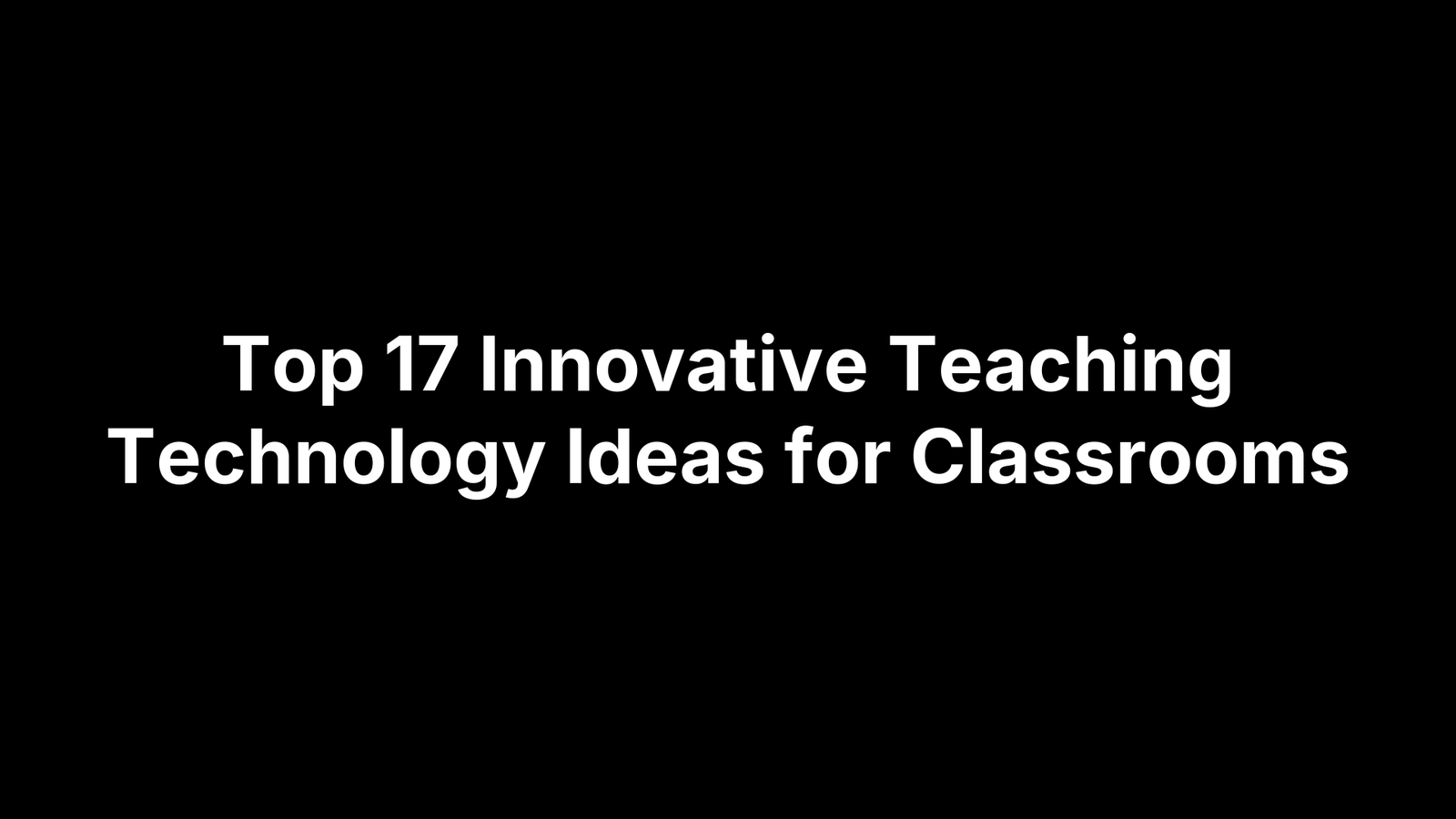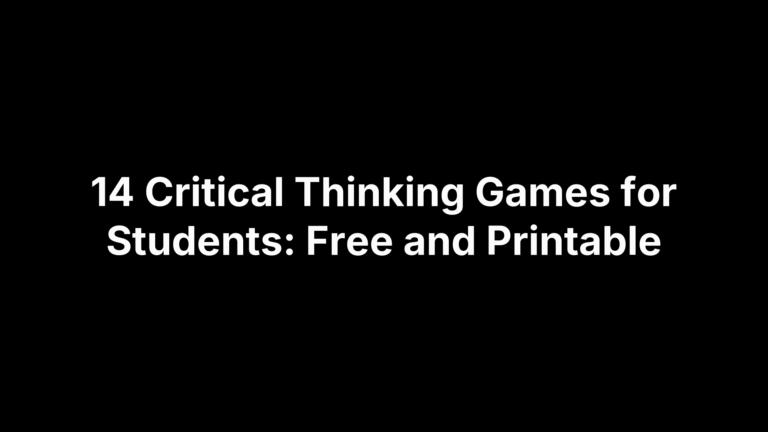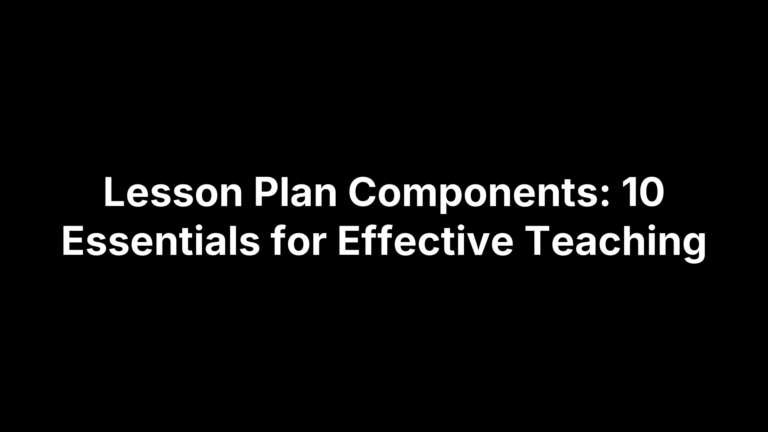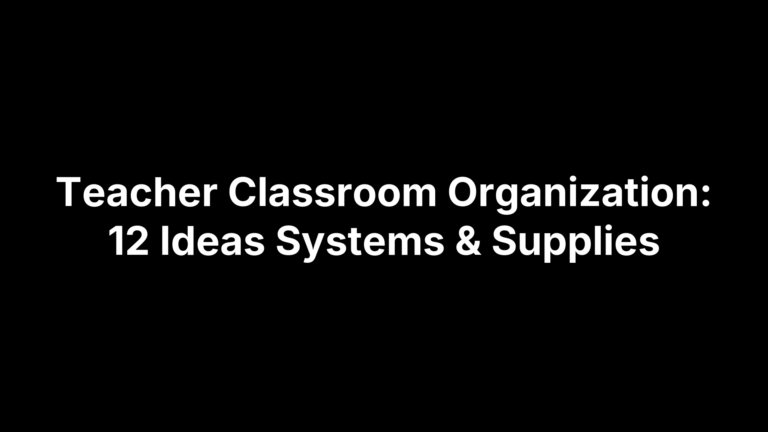Innovative Teaching Technology: Tools That Transform Learning
You know that worksheet drills and one-size-fits-all lectures rarely spark the lightbulb moment students deserve. What reliably moves the needle is innovative teaching technology—digital tools, platforms, and hardware that reimagine instruction and bring students into the driver’s seat of their own learning. Whether you teach fifth-grade fractions or AP Literature, smart tech can shave hours off prep time, personalize practice, and turn passive observers into active creators eager to explore.
Below you’ll find 17 classroom-ready ideas that cover the spectrum: AI assistants that build differentiated worksheets in minutes, VR field trips, podcasting stations, and more. All are budget-friendly, so you can focus on teaching, not troubleshooting. Each entry gives you a plain-language snapshot, clear learning benefits, and step-by-step setup directions so you can pilot a new tool this week—even if your comfort level with tech hovers around ‘novice’. Ready to upgrade the way your class learns, interacts, and achieves? Let’s jump in.
1. AI-Powered Teacher Toolkit: The Cautiously Optimistic Teacher
If you want a single dashboard that plans, personalizes, and even grades alongside you, the home-grown suite at The Cautiously Optimistic Teacher is hard to beat. Unlike siloed apps that do one thing well, this all-in-one hub wraps several AI engines around the daily tasks that swallow teacher time, making it the consummate example of truly innovative teaching technology.
What It Is & Why It Stands Out
Hosted on teachers-blog.com, the toolkit bundles four flagship tools—Differentiated Instruction Helper, Worksheet Maker, Question Generator, and Report Card Commentor—plus complete unit plans and mindset lessons. The magic is the way content and automation talk to each other: paste tomorrow’s reading excerpt, click “Generate,” and get leveled questions, extension prompts, and printable practice in under a minute. Because every output is editable, teachers keep pedagogical control while the algorithm does the heavy lifting.
Learning & Workflow Benefits
- Differentiation on demand: AI suggestions automatically vary reading level, modality, and question depth, mirroring Universal Design for Learning (UDL) principles.
- Built-in microlearning: bite-sized worksheet sections and quick-fire questions align with research showing students retain more from short, targeted practice.
- Data you can act on: exported analytics highlight which standards need reteaching—no extra spreadsheet wrangling required.
Together these perks free up prep periods and let you spend face-to-face minutes coaching rather than copying.
Quick Start Guide for Teachers
- Create a free account and explore the dashboard tour (3 minutes).
- Select one upcoming lesson—start small.
- Open Worksheet Maker, paste your source text or topic keywords, and hit Generate.
- Skim the AI draft, tweak wording, and choose print or digital push-out.
- Use the Question Generator for same-day exit tickets and share a growth-mindset article from the blog for homework reflection.
Try this sequence once, and you’ll see why AI is topping “newest tech in education” lists everywhere.
2. Gamified Learning Platforms
Think of gamification as the classroom cousin of FitBit streaks or Duolingo gems—small, well-timed rewards that keep people coming back for more. By layering game mechanics on top of academic content, these platforms tap into the brain’s dopamine loop, turning practice that might feel like drudgery into something students voluntarily chase. Many teachers cite gamification as the easiest entry point into innovative teaching technology because it works whether you’re 1:1, blended, or still rolling the projector cart in from the hallway.
Core Concept
At its simplest, gamification wraps curriculum in four pillars:
- Points that tally progress
- Badges that mark mastery
- Leaderboards that showcase status
- Narratives that frame the “why” behind each quest
Research shows that when learners can see incremental progress, retention rises and off-task behavior drops. That’s why “What is an example of an innovative teaching method?” so often gets answered with “blended learning coupled with gamification.”
Classroom Examples
| Platform | Best For | Quick Scenario |
|---|---|---|
| Classcraft | Behavior & SEL | House points for teamwork during group labs |
| Kahoot! | Formative checks | Lightning-round review before Friday quiz |
| Prodigy Math | Adaptive practice | Self-paced homework that feels like an RPG quest |
Remote? Set up a Kahoot! challenge mode so students can compete asynchronously over the weekend.
Implementation Tips & Pitfalls
- Pilot one unit first; let students co-create badge criteria so buy-in is high.
- Publish clear achievement thresholds—mystery rules breed frustration.
- Celebrate multiple pathways to success to prevent a single “top player” dynamic.
- Pull platform analytics into parent-teacher conferences; the data communicates effort better than a single letter grade.
Start small, iterate, and watch even reluctant learners lean forward in their seats.
3. Augmented & Virtual Reality Experiences
Few technologies pull students into the content quite like slipping on a headset or pointing a phone at a Merge Cube. Immersive media turns the abstract—Rome’s Colosseum, a beating heart, the surface of Mars—into something learners can explore, rotate, and even manipulate in real time. The result is deeper spatial memory, stronger empathy, and a sense of “being there” textbooks can’t touch.
Why Immersive Tech Matters
AR layers digital information atop the physical world, while VR shuts out the room and transports students to a fully simulated environment. Studies comparing traditional slideshows to immersive lessons show up to a 30 % jump in concept retention and significant gains in motivation. Virtual field trips also remove equity barriers: every student, not just the fundraising superstars, can tour the Louvre or dive a coral reef.
Tools & Content Libraries
| Tech | Grade Range | Stand-out Feature |
|---|---|---|
| Merge Cube (AR) | 3–12 | Hold planets, fossils, or DNA models in your hand |
| QuiverVision (AR coloring) | K–5 | 2-D coloring pages pop into 3-D animations |
| Google Arts & Culture VR | 4–12 | 1,500+ museum and heritage site tours |
| Nearpod VR lessons | 2–12 | Built-in questions for formative checks |
| ClassVR headsets | 4–12 | Teacher console pushes 360° scenes to every device |
Roll-Out Strategies on Any Budget
- No headset? Use smartphones with $10 cardboard viewers or run AR apps on tablets already in your cart.
- Keep sessions to 7–10 minutes to curb motion sickness; build in reflection breaks.
- Follow a simple lesson arc:
- Pre-teach key vocabulary and objectives.
- Explore the scene (students jot “Wow!” observations).
- Debrief with a think-pair-share or journal prompt.
Tip: Assign a student “safety officer” to track time and remind peers to sit if they feel woozy. With thoughtful structure, immersive tech quickly shifts from flashy novelty to a core piece of your innovative teaching technology toolkit.
4. Interactive Whiteboards & Smartboards
Touch-sensitive boards have quietly become a workhorse of innovative teaching technology: one surface lets you project slides, capture handwriting, mirror student devices, and record the whole lesson for replay. Because everything happens in real time, instruction stays fluid—no shuffling between doc cam, laptop, and whiteboard.
The Evolution from Chalk to Touch
Early single-point smartboards merely mimicked a mouse; modern models offer multi-touch gestures, palm-erase, and wireless casting. Many ships with built-in browsers and app stores, so you can annotate a live website or split-screen a YouTube clip beside a graphic organizer—features singled out in “best classroom technology” PAA lists.
Boosting Engagement & Accessibility
- Color-coded thinking maps keep cognitive load low.
- One-tap screen recording supports absent or multilingual learners.
- Onboard screen readers and closed-caption tools meet 504 and IEP requirements without extra hardware.
Practical Classroom Routines
- Start the day with a bell-ringer slide students mark up as they enter.
- During reading, invite a “class scribe” to drag and drop sentence parts into syntax categories.
- End Friday by exporting all annotations as a PDF and dropping it into your LMS.
Quick upkeep: calibrate weekly and wipe with isopropyl alcohol to avoid ghost touches. With these habits, your smartboard stays a high-impact asset rather than a dusty projection screen.
5. 3D Printing for Hands-On Learning
A tabletop 3D printer can turn digital sketches into tangible objects in a matter of hours, giving students the thrill of seeing ideas leap off the screen. As an innovative teaching technology, additive manufacturing marries STEM rigor with creative freedom, making abstract formulas and historic artifacts something learners can literally hold, measure, and critique.
Concept & Curriculum Connections
3D printing builds layer by layer from plastic filament, so every model is a live demonstration of coordinate planes, geometry, and material science. In ELA or social studies, replicas of cuneiform tablets or Shakespeare’s Globe add multisensory context that readings alone can’t match. The design–print–iterate loop also aligns neatly with NGSS engineering practices and project-based learning rubrics.
Example Projects
- Math: Students design and print nets of polyhedra, then calculate
SA = Σ(area of faces). - Biology: Create enlarged cell organelles, label parts, and assemble a “giant cell” puzzle.
- History: Reconstruct broken pottery from STL files of archaeological finds, sparking a discussion on cultural preservation.
- Engineering: Launch a mini-bridge challenge where groups test printed trusses for maximum load before failure.
Logistics & Management
- Software: Start with free Tinkercad; export
.STLfiles to slicer software like Cura. - Budget: One 1 kg spool (~$20) yields 100–120 small models—track filament use on a class spreadsheet.
- Safety: Post a “hot nozzle” sign, require goggles during removal, and enforce a cooldown period.
- Workflow: Set a print queue, assign a student tech lead each week, and display finished pieces in a rotating hallway showcase to celebrate learning across subjects.
When planned thoughtfully, 3D printing transforms curiosity into concrete learning evidence without blowing the budget or your prep time.
6. Cloud-Based Collaboration Suites
Nothing accelerates group work like putting every student in the same virtual document and watching ideas appear in real time. Cloud-based suites replace e-mail ping-pong and lost flash drives with a single, always-current workspace students can open from any device—even the phone on the bus ride home. For teachers, that means fewer “I left it on my other computer” excuses and a searchable record of who contributed what, when.
Why the Cloud Transforms Group Work
- Live co-authoring lets teams divide tasks transparently, building accountability without micromanagement.
- Automatic version history acts as an academic integrity safety net—rollback shows original thinking and prevents accidental deletions.
- Built-in accessibility (voice typing, screen readers, closed captions) pulls more learners into the conversation, aligning with UDL guidelines.
Popular Suites & Hidden Gems
| Suite | Stand-Out Feature | Classroom Perk |
|---|---|---|
| Google Workspace for Education | Comment threads with emoji reactions | Quick formative feedback in Docs |
| Microsoft 365 (web) | Immersive Reader | One-click readability support |
| Canva Docs (Edu plan) | Drag-and-drop design elements | Students create polished reports without extra software |
Tip: Activate guardian summaries in Google Classroom or Teams to keep parents in the loop without extra e-mails.
Lesson Workflow Suggestions
- Kick off a jigsaw research project: assign each expert group its own shared doc, then merge findings into a master slide deck.
- Run peer-editing stations—highlight sentences, tag peers with
@Name, and require two actionable comments before submission. - Maintain cloud lab notebooks; students paste photos of experiments directly from their phones, keeping data time-stamped.
Before launching, review your district’s data-privacy policy and send a short parent permission form. A five-minute setup today yields collaboration superpowers all year long.
7. Adaptive Learning Management Systems (LMS)
No two learners tackle material in the same way, and an adaptive LMS respects that. Think of it as a GPS for coursework: algorithms watch where a student stalls or speeds ahead, then reroute content, pacing, and support in real time. Instead of scrolling through a one-size-fits-all module, each learner sees resources tuned to their current performance. For teachers, that means less guesswork and more targeted conferencing—hallmarks of truly innovative teaching technology.
Personalized Pathways Explained
Behind the curtain, adaptive engines crunch quiz scores, time-on-task, and even click patterns. If a student nails prerequisite skills, the platform unlocks advanced challenges; struggle, and it serves up reteach videos, hints, or practice sets. Mastery criteria are transparent (score ≥ 85% on checkpoint = advance), so students monitor their own progress and set goals worth chasing.
Leading Platforms
| Platform | Key Adaptive Feature | Good Fit For |
|---|---|---|
| Canvas Mastery Paths | Branches content based on quiz score bands | Secondary & higher ed |
| Schoology AMP | Item-level analytics feed auto-differentiated assessments | District-wide rollouts |
| Khan Academy | Mastery learning maps with skill recommendations | Homework or RTI periods |
Deployment Roadmap
- Begin with a diagnostic quiz to seed the algorithm—10 questions usually suffice.
- Define 2–3 mastery thresholds (e.g.,
≥90%,70–89%,<70%) and link each to specific resources. - Schedule weekly “data huddles” where students review their dashboard and draft mini-goals.
- Use the LMS’s analytics tab to form flexible groups for workshops or enrichment labs.
- Revisit thresholds every unit; adjust rigor as the class matures.
Set up once, and the system quietly personalizes learning in the background while you reclaim precious instructional minutes.
8. Video-Based Microlearning & Flipped Classroom Tools
Long lectures are yesterday’s news. Microlearning breaks content into digestible video segments—think five-minute bursts students can watch on the bus or between practices. Pair those clips with a flipped model, and class time morphs from sit-and-get to hands-on problem solving. This approach counts as innovative teaching technology because it leverages streaming platforms students already use while freeing you to coach instead of recite.
Rationale for Bite-Sized Video
Cognitive load theory says working memory tops out at about four bits of new information (≈ 20 seconds). Videos under six minutes respect that limit, boosting retention and completion rates. Pre-class viewing also levels the playing field: students can pause, rewind, or turn on captions—built-in differentiation without extra prep.
Tools & Features
| Tool | Best Use | Killer Feature |
|---|---|---|
| Edpuzzle | Interactive checks | Auto-grades embedded questions |
| Loom | Teacher screencasts | Camera bubble keeps human presence |
| YouTube Chapters | Student navigation | Jump links for quick review |
Each platform provides analytics showing who watched, skipped, or re-watched, giving you instant formative data.
Flipped Implementation Checklist
- Record or curate a sub-6-minute video; add captions for accessibility.
- Upload to Edpuzzle or YouTube, embedding 2–3 comprehension questions.
- Assign as homework with a due-by timestamp; enable progress alerts.
- Open class with a one-question warm-up to verify understanding.
- Devote the bulk of period time to labs, debates, or guided practice.
- Close with a quick reflection poll and export analytics to your LMS.
Follow this loop once, and you’ll see how micro-video plus flipping transforms passive listeners into active learners—and hands you back precious instructional minutes.
9. Student Response Systems & Live Polling Apps
Nothing drains momentum like asking a question and hearing crickets. Student response systems replace those awkward pauses with instant, anonymous input that appears on your screen in seconds. Because every learner answers at once, you get a heat-map of understanding while attention is still high—and students feel their voice counts, even the shy ones in the back row. That real-time pulse check makes these apps a low-lift but high-impact slice of innovative teaching technology.
Instant Feedback Mechanics
Most tools offer a mix of formats:
- Multiple-choice for quick right/wrong checks
- Open-ended text for brainstorming or short-answer reasoning
- Word clouds that surface common themes or misconceptions
Responses populate in real time, so you can reteach immediately or green-light the next activity without guessing.
Tool Set
| App | Stand-out Feature | Device Support |
|---|---|---|
| Mentimeter | Live word clouds & quizzes | Any browser |
| Poll Everywhere | Clickable image questions | iOS, Android, Web |
| Slido | Up-vote Q&A to crowd-prioritize doubts | Web, Google Slides add-on |
| Google Classroom “Question” | Built into existing workflow | Chromebooks, mobile |
Engagement Playbook
- Launch a two-question pre-assessment as students enter; group by results for differentiated tasks.
- Schedule anonymous SEL check-ins midweek—emoji scales reveal stress pockets early.
- End class with a one-minute exit poll; export the analytics to spot patterns before planning tomorrow’s lesson.
Used strategically, live polling turns silence into data you can act on today, not after the unit test.
10. Coding & Robotics Kits
Rolling a robot across the floor or watching an LED blink after writing five lines of code delivers instant “I built that!” gratification. Coding and robotics kits turn abstract algorithms into tactile play, giving students a concrete entry point into computer science, engineering, and problem-solving. Because many kits now ship with drag-and-drop block coding, even primary grades can join the fun without typing a single semicolon.
Why Every Student Should Code
- Builds computational thinking—breaking big problems into testable chunks
- Reinforces math concepts like variables, loops, and coordinate planes
- Encourages persistence: immediate feedback makes failure a feature, not a flaw
- Opens career pathways; the Bureau of Labor Statistics projects 25 % growth in software jobs this decade
Kit Comparisons
| Kit | Approx. Price | Grade Range | Curriculum Highlights |
|---|---|---|---|
| LEGO Spike Prime | $330/core set | 4–8 | Scratch-based blocks, STEAM challenges, built-in sensors |
| Sphero Bolt | $180/robot | 3–9 | JavaScript or blocks, 360° light matrix, maze missions |
| micro:bit v2 | $18/board | 5–12 | Python or MakeCode, integrates with cardboard inventions |
Tip: start with one classroom set and rotate between stations to keep costs manageable.
Classroom Integration
- Kick off Hour of Code week by letting students program a micro:bit to display their initials.
- In math, map robot movement to coordinate grid lessons—
(x+10, y-5)becomes a real-world turn. - Launch an after-school robotics club that culminates in a friendly obstacle-course competition judged on speed and code efficiency.
- Tie reflection journals to each build cycle: What bug stumped you? How did you debug it?
Coding kits sit at the intersection of hands-on discovery and innovative teaching technology, empowering students to move from consumers of tech to creators—all within a single class period.
11. Podcasting & Audio Creation Stations
When students trade the red pen for a microphone, something magical happens—their ideas shift from “assignment” to “broadcast.” Podcasting taps into the same storytelling boom fueling Spotify charts, giving every learner a low-stakes way to polish speaking skills, practice research, and publish to an authentic audience. Because audio production emphasizes clarity over flashy visuals, it levels the playing field for multilingual learners and students who freeze at the sight of a blank page.
The Power of Student Voice
Recording pushes students to script tightly, rehearse fluency, and listen critically during edits. Class feedback sessions become miniature writer’s rooms where peers discuss tone, pacing, and evidence. The end product—a sharable MP3—creates built-in motivation: nobody wants filler words living online forever.
Hardware & Software
- USB mic: Blue Snowball or Fifine K669 (≈ $40)
- Headphones with inline mute
- Audacity (free, offline) for multi-track editing
- Soundtrap EDU (cloud-based, automatic leveling)
- Quiet corner or repurposed closet lined with cardboard egg cartons for DIY soundproofing
Project Ideas
- Historical “radio flash” recounting a key event as breaking news.
- Science myth-busting episode where groups debunk viral claims with cited studies.
- Monthly school-news roundup that doubles as a community outreach tool.
Publish episodes to the class LMS or a private Spotify anchor link, then invite families to tune in—instant celebration of learning without a single poster board.
12. Digital Storytelling & Multimedia Projects
Slides are fine, but nothing beats the spark that flies when students blend images, video, text, and audio into a single narrative package. Digital storytelling turns content review into publishable media, sharpening writing craft, media-literacy muscles, and tech fluency in one go. Because projects live online, families and authentic audiences can comment, making feedback feel real rather than perfunctory.
Narrative + Technology
The heart of digital storytelling is a classic story arc (hook, rising action, climax, resolution) delivered through mixed media. Students learn to storyboard like filmmakers, write tight voice-overs, and choose visuals that advance meaning instead of filling space. Research shows that pairing words with relevant imagery nearly doubles recall (dual-coding theory), which is why multimedia pieces stick long after a unit test.
Toolbox
| Tool | Best For | Why Teachers Love It |
|---|---|---|
| Adobe Express Pages | Photo essays | Drag-and-drop layout + auto themes |
| Book Creator | Interactive e-books | One-click read-aloud for accessibility |
| Canva Video Stories | Social-style reels | Stock footage and music in the EDU plan |
Rubric & Workflow
- Storyboard: sketch scene thumbnails; approve focus and message.
- Asset list: gather copyright-safe images, clips, and sound effects.
- Draft: import assets, record narration, add captions for UDL compliance.
- Peer review: swap links, leave two glow/grow comments tied to rubric traits (clarity, evidence, design).
- Publish: generate a QR code, post on a hallway “story wall,” and reflect on audience reactions.
Build this cycle into any unit and watch students become directors of their own learning tales.
13. Data Analytics & Learning Dashboards
You already track grades, but raw numbers rarely tell the whole story. Learning dashboards turn that spreadsheet soup into color-coded visuals—heat maps, trend lines, mastery meters—that spotlight who’s cruising, who’s coasting, and where misconceptions pile up. Instead of waiting for end-unit tests, you can intervene tomorrow, making data analytics one of the most quietly powerful pieces of innovative teaching technology.
From Grades to Actionable Insights
Dashboards aggregate multiple data streams—quiz scores, time-on-task, even discussion-post counts—then transform them into at-a-glance indicators. A red segment might flag a standard students miss repeatedly; a green upward arrow could confirm that last week’s reteach stuck. Because insights update in real time, you can shift groups or tweak pacing mid-lesson rather than post-mortem.
Available Solutions
| Tool | Snapshot Feature | Ideal Use Case |
|---|---|---|
| Google Classroom ➜ Sheets ➜ Data Studio | Auto-refresh heat maps | Quick, no-cost overview |
| Power BI Education Templates | Drill-down filters by subgroup | District or departmental reviews |
| Classcraft Analytics | SEL + behavior overlays | Tier-one interventions |
| Canvas Analytics Beta | Activity vs. performance scatterplots | College-prep progress tracking |
All options support CSV exports, so you can mash up data sources without complex coding.
Using Data for Differentiation
- Schedule a “dashboard Monday” where students examine their own charts and set micro-goals.
- Form flexible groups: red = reteach mini-lesson, yellow = guided practice, green = enrichment project.
- Share trend snapshots during parent conferences to replace vague comments with concrete visuals.
- Reflect monthly: which instructional moves precede spikes in mastery? Duplicate what works, drop what doesn’t.
Harnessed well, analytics let you teach proactively instead of reactively—turning every data point into a roadmap for more equitable learning.
14. Online Simulation & Virtual Labs
You don’t need Bunsen burners or thousand-dollar chemicals to get students experimenting. Browser-based simulations and virtual labs model everything from projectile motion to enzyme kinetics with click-and-drag ease. Because data resets instantly, classes can run multiple trials, tweak variables, and see patterns emerge in minutes—an efficiency brick-and-mortar labs just can’t match. Even better, these tools fold neatly into blended schedules, making them a budget-friendly slice of innovative teaching technology for schools short on space or supplies.
Why Simulations Work
Interactive models satisfy three big learning needs:
- Safety: Students explore hazardous scenarios (e.g., radioactive decay) minus real-world risk.
- Repetition: Unlimited “do-overs” let learners refine hypotheses without burning through materials.
- Visual feedback: Animated graphs and meters turn invisible forces into visible cause-and-effect, boosting conceptual transfer and retention.
Recommended Platforms
| Platform | Grade Range | Stand-out Feature |
|---|---|---|
| PhET Interactive Sims | 3–12 | Free HTML5 sims plus downloadable worksheets |
| Labster | 9–12+ | Story-driven 3-D labs with built-in assessments |
| Gizmos (ExploreLearning) | 3–12 | Adjustable sliders for real-time data tables |
Lesson Integration
- Pre-lab: Have students complete a hypothesis sheet predicting outcomes.
- Simulation session: Assign specific variable changes (
temperature ↑,pH ↓) and require screenshot evidence of results. - Post-lab: Facilitate a real-world case study—How does the virtual data inform environmental policy or medical decisions?
- Assessment: Use platform analytics or export CSVs to your LMS for quick grading.
With clear scaffolds, online sims move science from “tell me” to “show me,” all within a single class period.
15. Social Learning Networks & Discussion Forums
A good conversation doesn’t have to end when the period does. Social learning networks extend classroom talk into a low-pressure, scrollable space where every student—extrovert or introvert—can weigh in at their own pace. Because posts can embed images, links, or quick videos, the medium rewards curiosity and peer teaching while doubling as an archive of collective thinking. That mix of accessibility and accountability makes discussion forums a quietly powerful piece of innovative teaching technology.
Community Beyond the Classroom
When students craft a post that classmates can like, reply to, or remix, motivation shifts from “please the teacher” to “inform the community.” Threads also capture misconceptions in real time, allowing you to jump in with clarifying mini-lessons or seed deeper questions. Over time, the forum becomes a living study guide students build together.
Platforms & Settings
| Platform | Best Fit | Privacy Controls |
|---|---|---|
| Edmodo | K–8 homerooms | Teacher-approved joins, parent view |
| Canvas Discussions | Secondary & college | Section-based groups, speed-grader tie-in |
| Private Subreddit | Clubs & electives | Invite-only subreddit, Reddit auto-mod |
Moderation & Assessment Tips
- Post a netiquette contract; model first replies using sentence stems like “I appreciate your point because …”.
- Require evidence: link, page number, or timestamp in every initial post to curb opinion-only answers.
- Use a simple rubric—timeliness (1 pt), depth (2 pts), interaction (2 pts)—and grade with built-in analytics.
- Rotate student “discussion facilitators” weekly to build leadership and lighten your monitoring load.
With clear norms and purposeful prompts, online forums transform side chatter into substantive, student-driven learning.
16. Mobile Learning & BYOD Strategies
Phones, tablets, and personal laptops are already humming in backpacks. Instead of fighting the impulse, a well-planned BYOD (bring your own device) program channels that pocket power into just-in-time research, on-the-fly collaboration, and formative feedback loops—all without new hardware purchases. Done right, mobile learning extends innovative teaching technology beyond the classroom walls while keeping students on the tools they know best.
Leveraging Devices Students Already Own
- Push bite-sized content through LMS mobile apps so homework fits in daily commutes.
- Pair devices with low-cost AR apps for location-based scavenger hunts that make hallways part of the lesson.
- Use vocabulary flashcard apps that sync progress across phones and Chromebooks for seamless practice.
Policy & Equity Considerations
- Draft an acceptable-use agreement outlining when cameras, chat, and gaming are off-limits.
- Create a charging station or power-strip “bar” to prevent the dreaded 2 % battery panic.
- Budget for a small set of loaner devices and portable hotspots so every student can participate, not just the tech-privileged.
Sample Activities
- QR-code gallery walk: students scan art pieces to reveal curator audio notes.
- Real-time translation: language learners use Google Translate’s camera function to annotate community signage.
- Poll-based review game: students submit answers via phones; results project live for instant reteaching.
- Outdoor data capture: science classes record temperature and GPS tags, then upload to a shared map in real time.
With thoughtful guidelines and creative tasks, BYOD transforms everyday gadgets into always-ready learning tools that meet students where they—and their devices—already are.
17. Voice Assistants & Chatbots for Personalized Support
Smart speakers and text-based bots are quietly becoming the classroom aides you don’t have to supervise. By off-loading routine questions—“When is the quiz?” or “What’s a prime number again?”—they free you to focus on higher-impact coaching. Even better, the always-on, judgment-free nature of conversational AI gives shy or struggling students a low-stakes way to seek help, making it a natural extension of any innovative teaching technology toolkit.
The Rise of Conversational AI
Voice assistants (Amazon Echo, Google Nest) and browser bots built with tools like Dialogflow or Microsoft Power Virtual Agents translate natural language into actionable responses. Under the hood, large language models match queries to intents, pulling answers from a knowledge base you control. Set up correctly, they pronounce vocabulary, read passages aloud, or quiz students with randomized questions—24/7 and in multiple languages.
Classroom Use Cases
- Special education: configure read-aloud routines or step-by-step task instructions students can trigger on demand.
- World languages: have learners practice pronunciation; the assistant rates accuracy and suggests corrections.
- Homework hotline: embed a chatbot on your LMS that fields due-date, rubric, and citation questions after school hours.
- Revision buddy: students ask, “Explain photosynthesis at a 7th-grade level,” and the bot delivers a concise refresher.
Setup & Safety
- Choose your platform; start with a free Google Chatbot or Alexa Blueprint.
- Script a limited knowledge base—focus on syllabus info and core concepts to avoid misinformation.
- Disable purchasing, location sharing, and personal data collection in device settings.
- Teach students to verify answers against class notes and cite the bot like any other source.
With clear boundaries and purposeful scripting, conversational AI becomes a scalable co-teacher that personalizes support without piling more work on your plate.
Key Takeaways & Next Steps
Adopting even one of these 17 ideas can shift your classroom from “busy” to “breakthrough” almost overnight. Here’s the gist:
- Innovative teaching technology is less about shiny gadgets and more about freeing time for human connection.
- Small pilots beat giant overhauls—test a single feature, gather feedback, iterate, then scale.
- Data and differentiation go hand in hand; the best tools surface insights you can act on tomorrow.
- Equity is non-negotiable: pair any new tech with clear policies, low-cost alternatives, and accessibility settings.
Ready to roll? Pick the strategy that solves your biggest pain point, bookmark this list, and set a calendar reminder to try another in two weeks. For deeper walkthroughs, printable checklists, and free AI tools, swing by The Cautiously Optimistic Teacher and keep your momentum humming all year.






